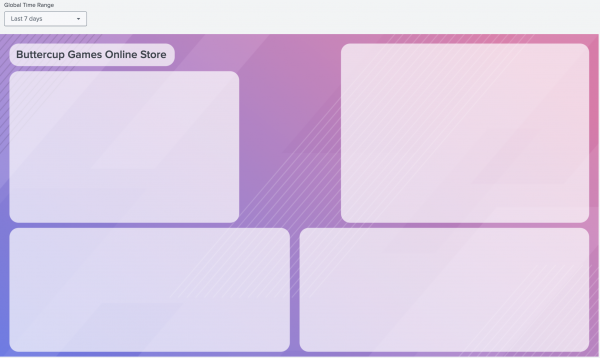Part 2 Create a dashboard
To tell a story about the revenue and purchasing trends of Buttercup Games, create a dashboard in Splunk Dashboard Studio with compelling visualizations powered by insightful searches.
Select a layout option
Splunk Dashboard Studio provides two different layout options: grid and absolute. In the grid layout, visualizations have automatic, snap-to-alignment. The grid layout is best for a quick dashboard building experience. The absolute layout provides more flexibility with pixel-perfect control and customizable backgrounds, shapes, and icons. For this tutorial, select the absolute layout. To learn more about both layouts, you can compare their functionality. See Compare absolute and grid layouts.
- Select Create New Dashboard from the Dashboards tab of the Search & Reporting app.
- Title your dashboard Buttercup Games Online Store and add Dashboard Studio Tutorial in the description box.
- (Optional) Select Edit ID to change your Dashboard ID. By default, the Dashboard ID is the same as the Dashboard Title. You can edit the Dashboard Title at any time, but you can't change the Dashboard ID later.
- Choose Private or Shared in App in the Permissions drop-down menu. Other app users can see your dashboard with the Shared in App option.
- Select the Dashboard Studio option to build your dashboard.
- Select the Absolute layout.
- Select Create.
Let's get acquainted with the two editing options available in Splunk Dashboard Studio: the visual editor and the source code editor. Although it's not always necessary to open the source code editor to build a dashboard, you can edit the source code for more flexibility beyond the visual editor.
About the visual editor
In this tutorial, you can practice using tools in the editing toolbar to customize a dashboard. For example, you can add objects to a dashboard, adjust visual formatting options, and access the data overview panel.
In the Configuration panel, you can adjust canvas settings, preferences, and view options. See Set up a dashboard.
About the source code editor
The source code for Splunk Dashboard Studio is JSON-based. Each dashboard has the following five stanzas in its source code:
- visualizations
- dataSources
- inputs
- layout
- defaults
By editing the source code, you can apply customization options to your dashboard. The source code for your dashboard in this tutorial will look like the following:
{
"visualizations": {},
"dataSources": {},
"defaults": {...},
"inputs": {},
"layout": {...},
"description": "Dashboard Studio Tutorial",
"title": "Buttercup Games Online Store"
}
In this tutorial, you will work with the source code editor in Part 10: Apply customization options with dashboard default settings. You can view the dashboard definition in the source code editor. See What is a dashboard definition.
Set up the dashboard canvas
Before adding visualizations to your dashboard, prepare the canvas by adding a background image and some shapes. Preparing the dashboard canvas with design elements can help you later when choosing visual formatting options for visualizations.
- For this tutorial, open the Buttercup Games background image in a new tab and download the image to add to your dashboard.
- Using the Configuration panel, make sure the Display Mode is set to Fit to Width.
- Change Canvas Width to 1300 and Canvas Height to 700. To learn more, see Compare absolute and grid layouts.
- In the Background Image section of the Configuration panel, upload the Buttercup Games background image.
The image size limit for Dashboard Studio is 16 MB.
- Change the background image size setting from Contain to Cover.
- Under Preferences, deselect Show Title & Description
- Add an in-page title by selecting the add Markdown icon (
 ) in the editing toolbar.
) in the editing toolbar. - Enter
# Buttercup Games Online Storein the text box. - Resize and position the text box to fit in the gray box under the time range picker.
After completing Part 2, your dashboard will look similar to the following:
Next step
You've completed Part 2 of the Splunk Dashboard Studio tutorial.
Now you have a canvas ready for visualizations. Next, add a new data source and assign it to a table visualization. Continue to Part 3: Add a table with column formatting.
| Part 1 Getting started with the Splunk Dashboard Studio tutorial | Part 3 Add a table with column formatting |
This documentation applies to the following versions of Splunk® Enterprise: 9.0.3, 9.0.4, 9.0.5, 9.0.6, 9.0.7, 9.0.8, 9.0.9, 9.0.10

 Download manual
Download manual
Feedback submitted, thanks!